TOYOTA LAND CRUISER 2012 Owners Manual
Manufacturer: TOYOTA, Model Year: 2012, Model line: LAND CRUISER, Model: TOYOTA LAND CRUISER 2012Pages: 692, PDF Size: 29.3 MB
Page 171 of 692
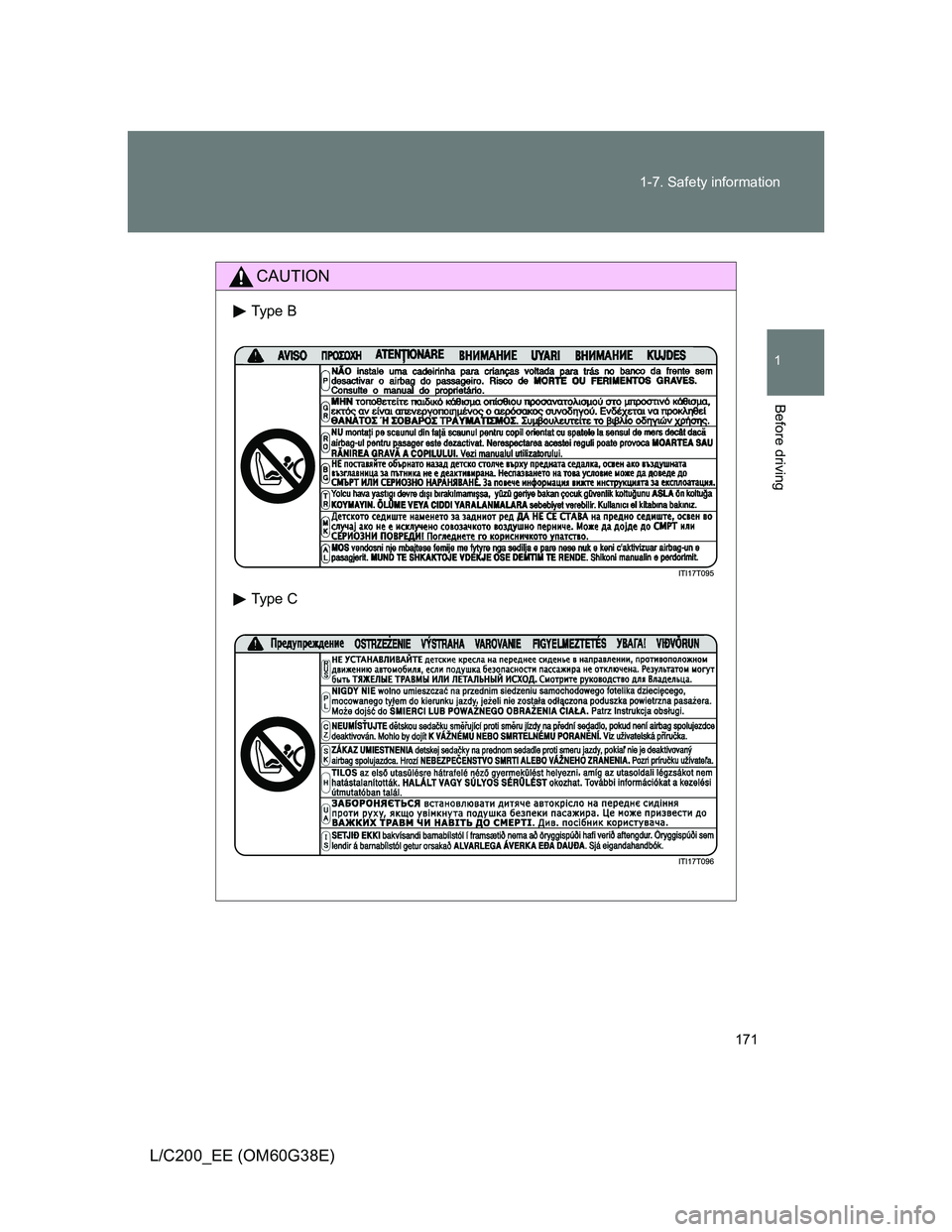
171 1-7. Safety information
1
Before driving
L/C200_EE (OM60G38E)
CAUTION
Type B
Type C
Page 172 of 692
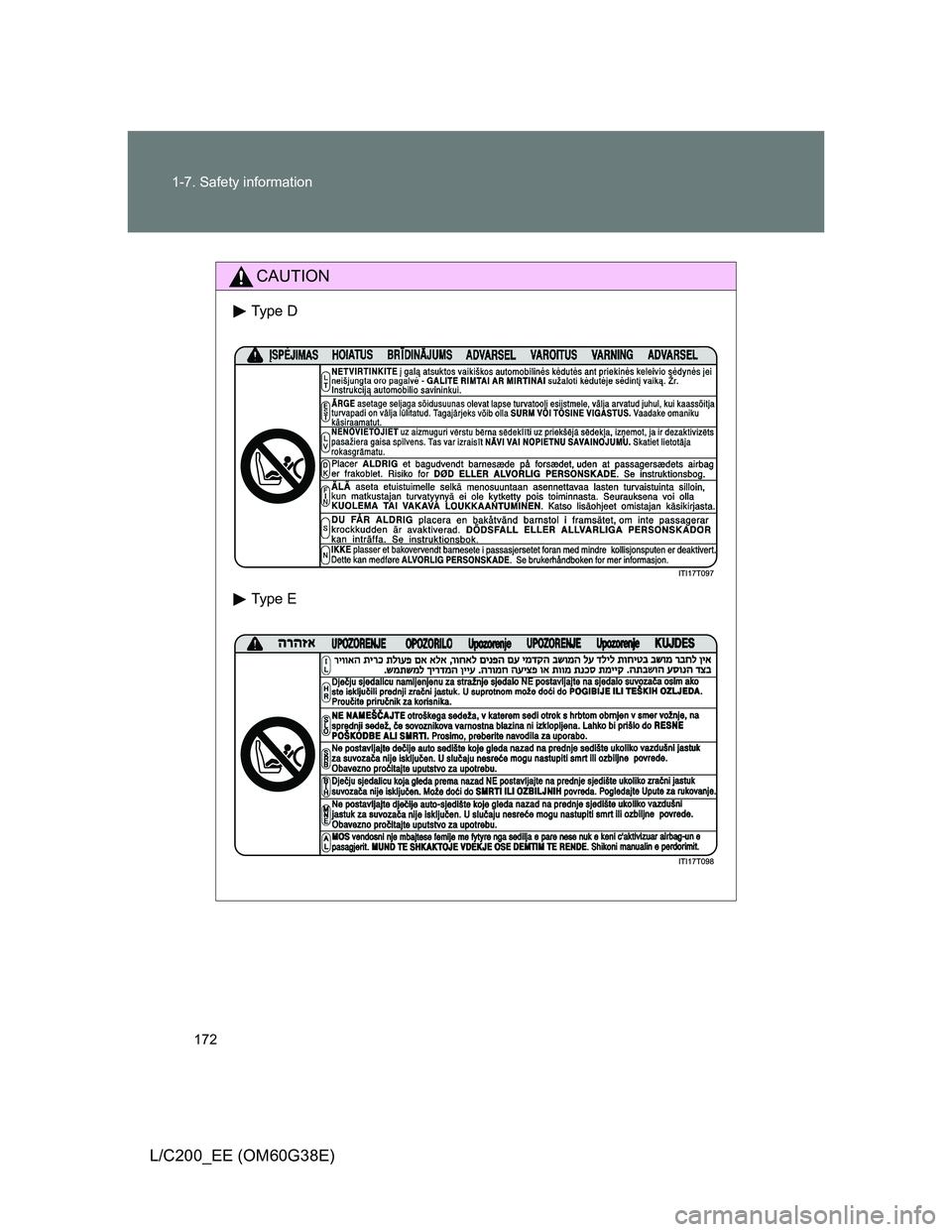
172 1-7. Safety information
L/C200_EE (OM60G38E)
CAUTION
Type D
Type E
Page 173 of 692
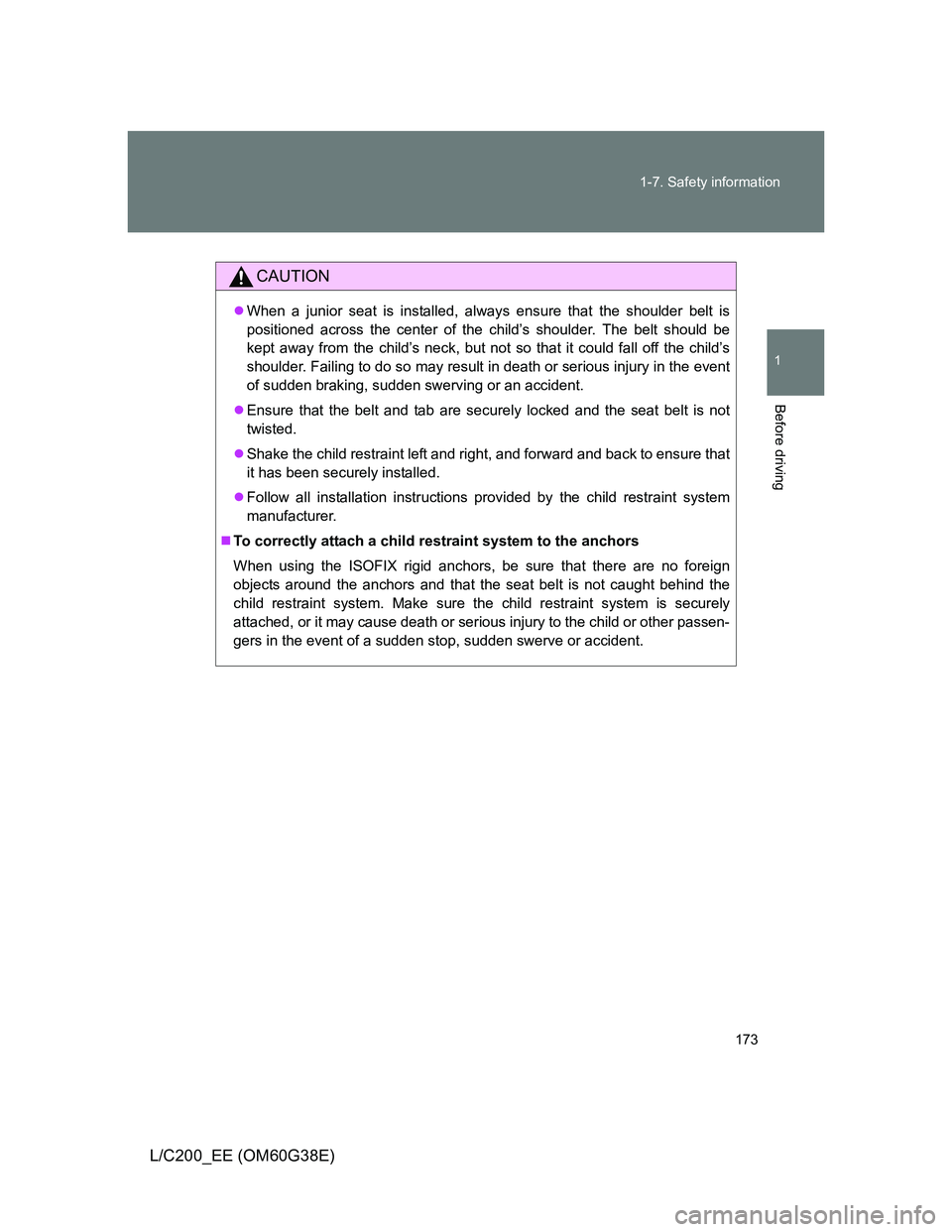
173 1-7. Safety information
1
Before driving
L/C200_EE (OM60G38E)
CAUTION
When a junior seat is installed, always ensure that the shoulder belt is
positioned across the center of the child’s shoulder. The belt should be
kept away from the child’s neck, but not so that it could fall off the child’s
shoulder. Failing to do so may result in death or serious injury in the event
of sudden braking, sudden swerving or an accident.
Ensure that the belt and tab are securely locked and the seat belt is not
twisted.
Shake the child restraint left and right, and forward and back to ensure that
it has been securely installed.
Follow all installation instructions provided by the child restraint system
manufacturer.
To correctly attach a child restraint system to the anchors
When using the ISOFIX rigid anchors, be sure that there are no foreign
objects around the anchors and that the seat belt is not caught behind the
child restraint system. Make sure the child restraint system is securely
attached, or it may cause death or serious injury to the child or other passen-
gers in the event of a sudden stop, sudden swerve or accident.
Page 174 of 692
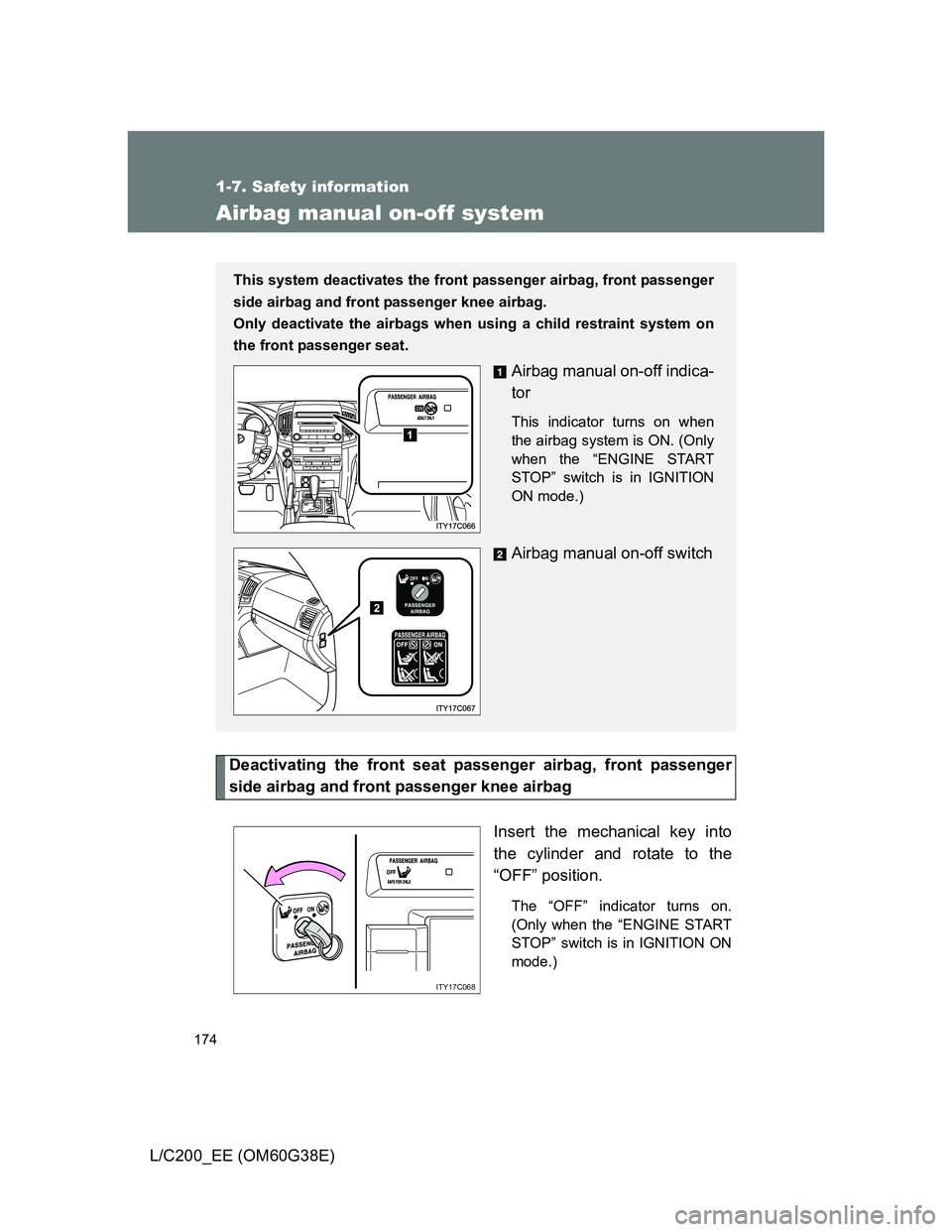
174
1-7. Safety information
L/C200_EE (OM60G38E)
Airbag manual on-off system
Deactivating the front seat passenger airbag, front passenger
side airbag and front passenger knee airbag
Insert the mechanical key into
the cylinder and rotate to the
“OFF” position.
The “OFF” indicator turns on.
(Only when the “ENGINE START
STOP” switch is in IGNITION ON
mode.)
This system deactivates the front passenger airbag, front passenger
side airbag and front passenger knee airbag.
Only deactivate the airbags when using a child restraint system on
the front passenger seat.
Airbag manual on-off indica-
tor
This indicator turns on when
the airbag system is ON. (Only
when the “ENGINE START
STOP” switch is in IGNITION
ON mode.)
Airbag manual on-off switch
ITY17C068
Page 175 of 692
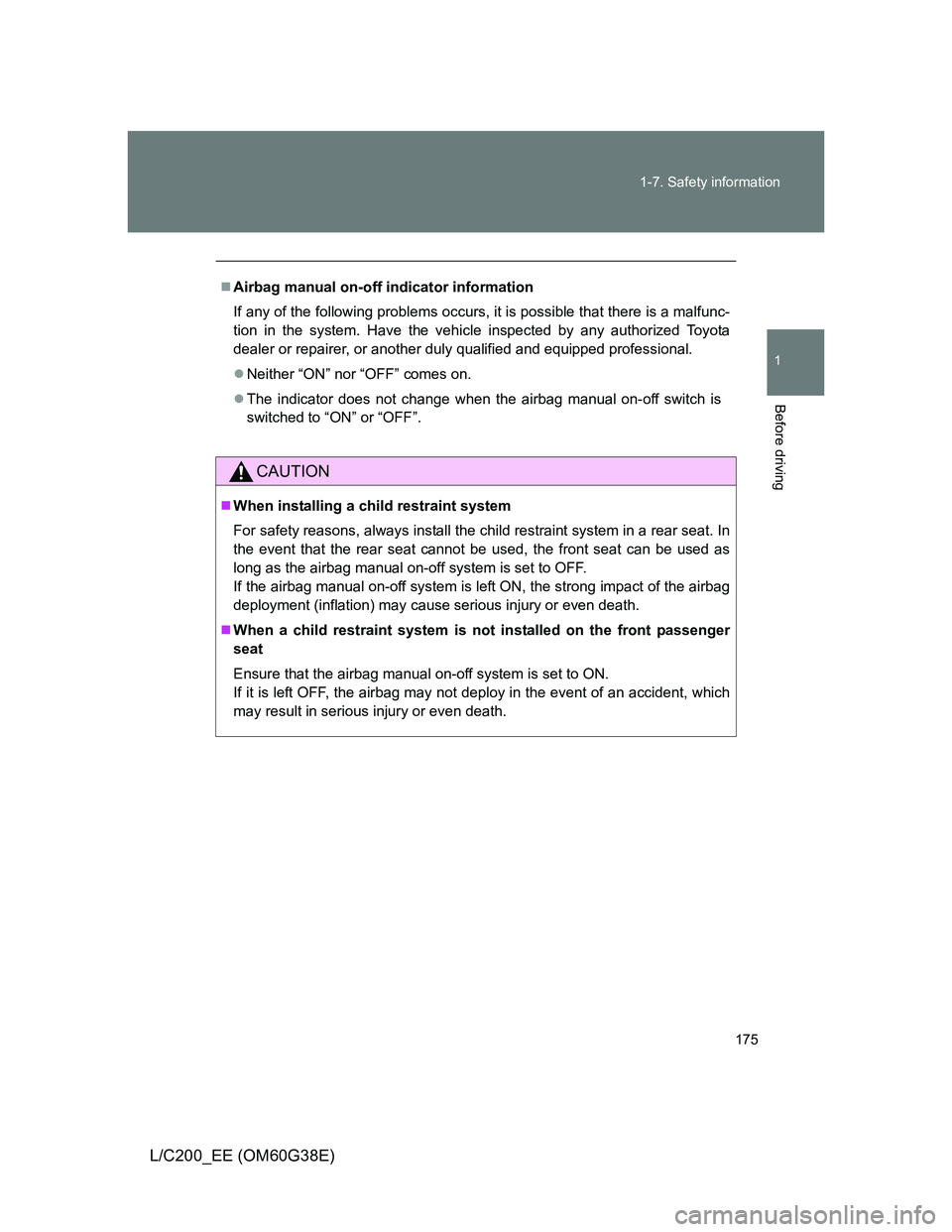
175 1-7. Safety information
1
Before driving
L/C200_EE (OM60G38E)
Airbag manual on-off indicator information
If any of the following problems occurs, it is possible that there is a malfunc-
tion in the system. Have the vehicle inspected by any authorized Toyota
dealer or repairer, or another duly qualified and equipped professional.
Neither “ON” nor “OFF” comes on.
The indicator does not change when the airbag manual on-off switch is
switched to “ON” or “OFF”.
CAUTION
When installing a child restraint system
For safety reasons, always install the child restraint system in a rear seat. In
the event that the rear seat cannot be used, the front seat can be used as
long as the airbag manual on-off system is set to OFF.
If the airbag manual on-off system is left ON, the strong impact of the airbag
deployment (inflation) may cause serious injury or even death.
When a child restraint system is not installed on the front passenger
seat
Ensure that the airbag manual on-off system is set to ON.
If it is left OFF, the airbag may not deploy in the event of an accident, which
may result in serious injury or even death.
Page 176 of 692

176 1-7. Safety information
L/C200_EE (OM60G38E)
Page 177 of 692
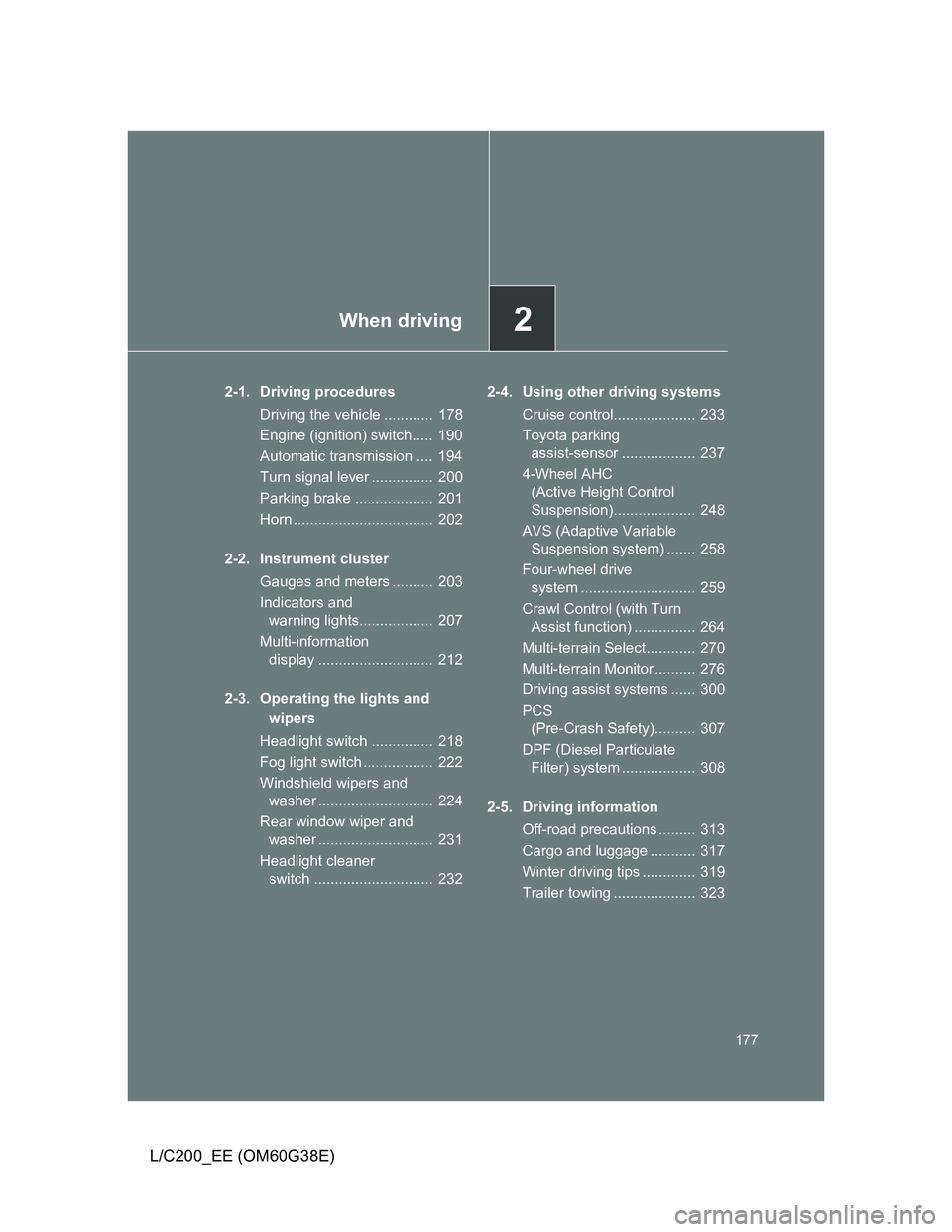
2When driving
177
L/C200_EE (OM60G38E)
2-1. Driving procedures
Driving the vehicle ............ 178
Engine (ignition) switch..... 190
Automatic transmission .... 194
Turn signal lever ............... 200
Parking brake ................... 201
Horn .................................. 202
2-2. Instrument cluster
Gauges and meters .......... 203
Indicators and
warning lights.................. 207
Multi-information
display ............................ 212
2-3. Operating the lights and
wipers
Headlight switch ............... 218
Fog light switch ................. 222
Windshield wipers and
washer ............................ 224
Rear window wiper and
washer ............................ 231
Headlight cleaner
switch ............................. 2322-4. Using other driving systems
Cruise control.................... 233
Toyota parking
assist-sensor .................. 237
4-Wheel AHC
(Active Height Control
Suspension).................... 248
AVS (Adaptive Variable
Suspension system) ....... 258
Four-wheel drive
system ............................ 259
Crawl Control (with Turn
Assist function) ............... 264
Multi-terrain Select ............ 270
Multi-terrain Monitor .......... 276
Driving assist systems ...... 300
PCS
(Pre-Crash Safety).......... 307
DPF (Diesel Particulate
Filter) system .................. 308
2-5. Driving information
Off-road precautions ......... 313
Cargo and luggage ........... 317
Winter driving tips ............. 319
Trailer towing .................... 323
Page 178 of 692
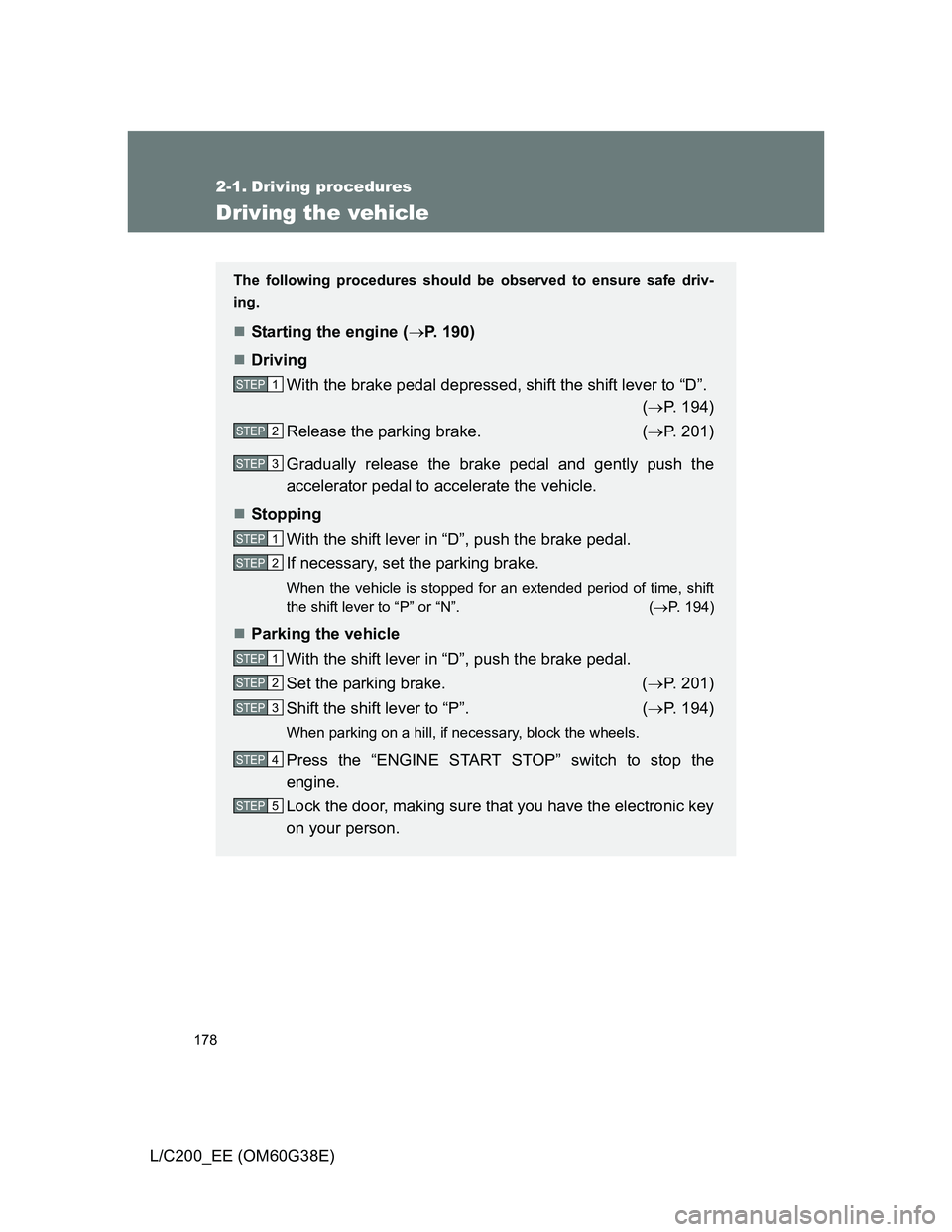
178
L/C200_EE (OM60G38E)
2-1. Driving procedures
Driving the vehicle
The following procedures should be observed to ensure safe driv-
ing.
Starting the engine (P. 190)
Driving
With the brake pedal depressed, shift the shift lever to “D”.
(P. 194)
Release the parking brake. (P. 201)
Gradually release the brake pedal and gently push the
accelerator pedal to accelerate the vehicle.
Stopping
With the shift lever in “D”, push the brake pedal.
If necessary, set the parking brake.
When the vehicle is stopped for an extended period of time, shift
the shift lever to “P” or “N”. (P. 194)
Parking the vehicle
With the shift lever in “D”, push the brake pedal.
Set the parking brake. (P. 201)
Shift the shift lever to “P”. (P. 194)
When parking on a hill, if necessary, block the wheels.
Press the “ENGINE START STOP” switch to stop the
engine.
Lock the door, making sure that you have the electronic key
on your person.
STEP1
STEP2
STEP3
STEP1
STEP2
STEP1
STEP2
STEP3
STEP4
STEP5
Page 179 of 692
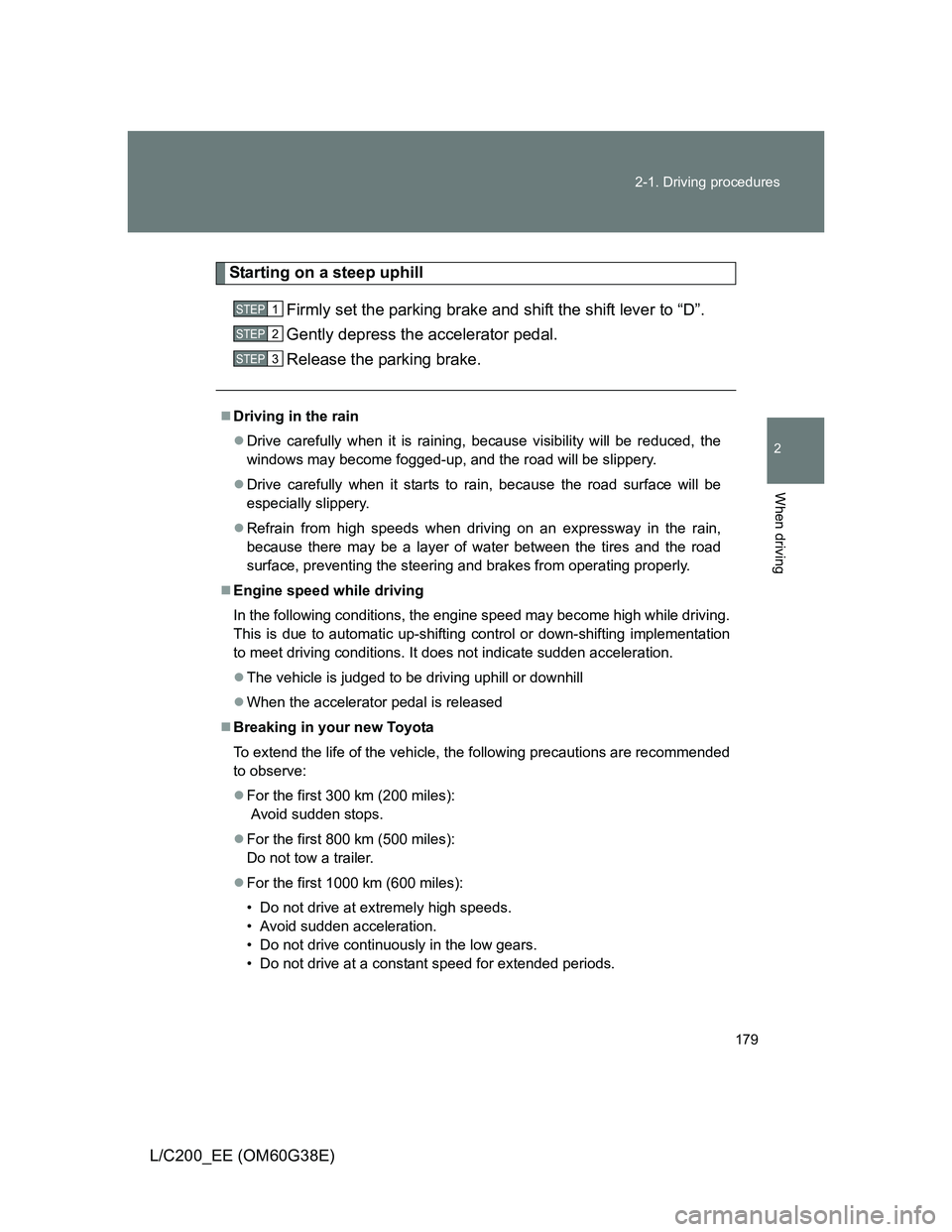
179 2-1. Driving procedures
2
When driving
L/C200_EE (OM60G38E)
Starting on a steep uphill
Firmly set the parking brake and shift the shift lever to “D”.
Gently depress the accelerator pedal.
Release the parking brake.
Driving in the rain
Drive carefully when it is raining, because visibility will be reduced, the
windows may become fogged-up, and the road will be slippery.
Drive carefully when it starts to rain, because the road surface will be
especially slippery.
Refrain from high speeds when driving on an expressway in the rain,
because there may be a layer of water between the tires and the road
surface, preventing the steering and brakes from operating properly.
Engine speed while driving
In the following conditions, the engine speed may become high while driving.
This is due to automatic up-shifting control or down-shifting implementation
to meet driving conditions. It does not indicate sudden acceleration.
The vehicle is judged to be driving uphill or downhill
When the accelerator pedal is released
Breaking in your new Toyota
To extend the life of the vehicle, the following precautions are recommended
to observe:
For the first 300 km (200 miles):
Avoid sudden stops.
For the first 800 km (500 miles):
Do not tow a trailer.
For the first 1000 km (600 miles):
• Do not drive at extremely high speeds.
• Avoid sudden acceleration.
• Do not drive continuously in the low gears.
• Do not drive at a constant speed for extended periods.
STEP1
STEP2
STEP3
Page 180 of 692
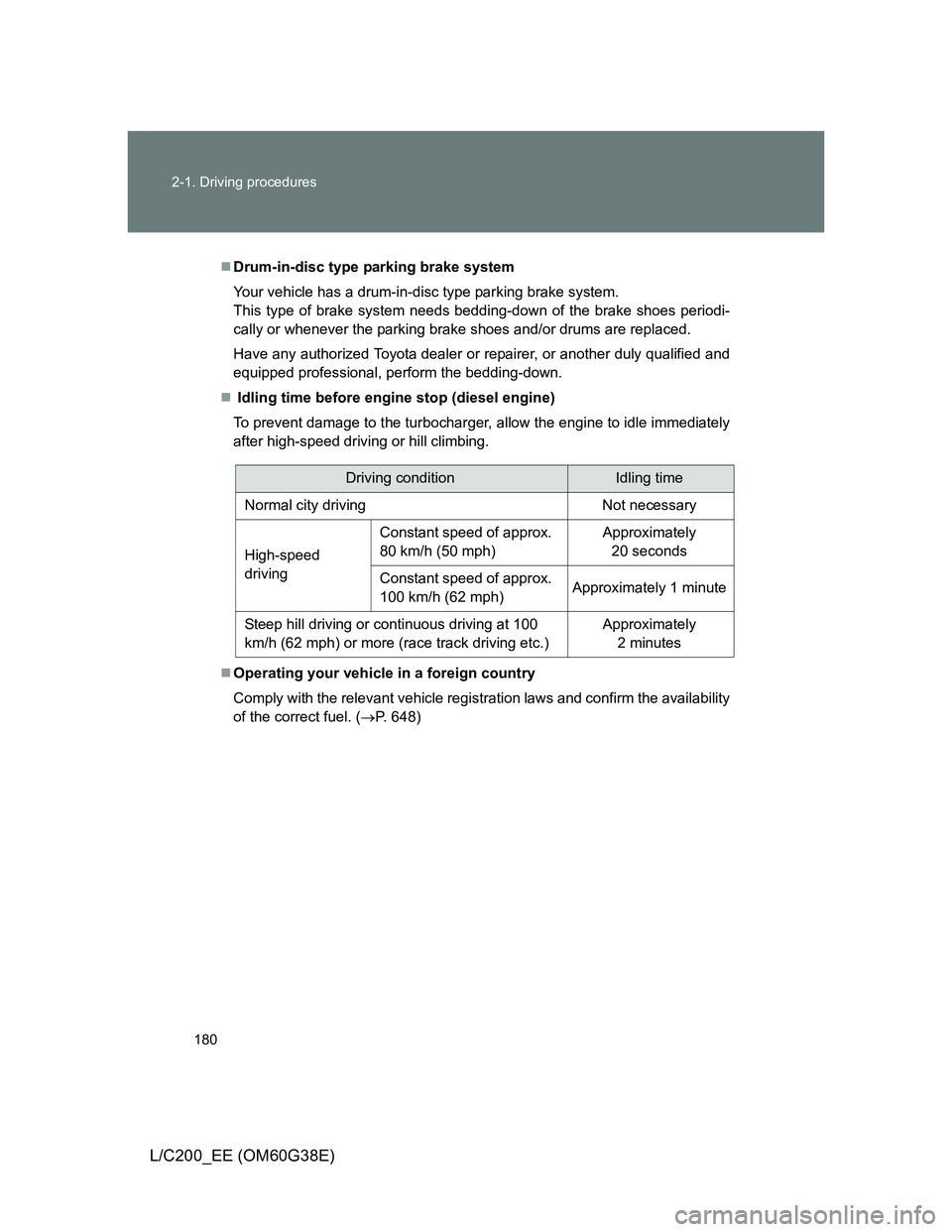
180 2-1. Driving procedures
L/C200_EE (OM60G38E)
Drum-in-disc type parking brake system
Your vehicle has a drum-in-disc type parking brake system.
This type of brake system needs bedding-down of the brake shoes periodi-
cally or whenever the parking brake shoes and/or drums are replaced.
Have any authorized Toyota dealer or repairer, or another duly qualified and
equipped professional, perform the bedding-down.
Idling time before engine stop (diesel engine)
To prevent damage to the turbocharger, allow the engine to idle immediately
after high-speed driving or hill climbing.
Operating your vehicle in a foreign country
Comply with the relevant vehicle registration laws and confirm the availability
of the correct fuel. (P. 648)
Driving conditionIdling time
Normal city driving Not necessary
High-speed
drivingConstant speed of approx.
80 km/h (50 mph)Approximately
20 seconds
Constant speed of approx.
100 km/h (62 mph)Approximately 1 minute
Steep hill driving or continuous driving at 100
km/h (62 mph) or more (race track driving etc.)Approximately
2 minutes